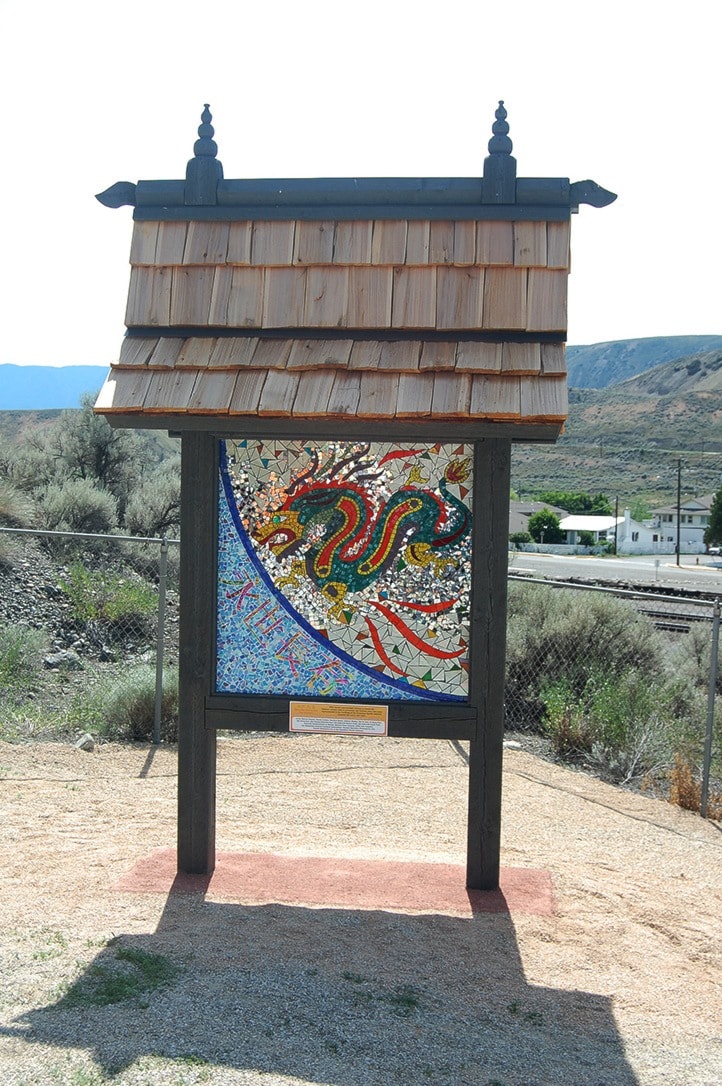Last week’s story about the mosaics unveiled in the Ashcroft Chinese cemetery was well-liked online, where numerous readers shared it with friends. Somehow the story about a small corner of British Columbia was forwarded to Sue Silver, interim director of the Mineral County Museum in Hawthorne, Nevada, about 300 miles northwest of Las Vegas.
Within 24 hours of the story appearing, Silver had e-mailed The Journal. “What a great project to cover!” she wrote. “I was wondering if you took any additional photos of the mosaic and country-style frame. I’ve been looking for a rural-type structure to place at our Chinese cemetery that was ‘lost’ for more than 70 years. We have been working to get it fenced and properly marked, and this temple frame looks like it may just be what we’re looking for; minus the mosaic, though. We have too much blowing sand to put up anything that beautiful.”
I was able to send more detailed pictures, and also put Silver in touch with Daniel Collett, who designed the frame, and who said he would be happy to share the plans. Silver wrote back, saying that “I showed the temple structure to my County Commissioner and she agrees this is a perfect fit for our needs. I will contact Daniel Collett about the plans and to personally praise his work.”
She also supplied some history about Hawthorne and its “lost” Chinese cemetery. The town (current population 3,200) has a good many similarities with Ashcroft: it was founded in the 1880s as a railroad town, with Chinese workers coming south to work on the Carson and Colorado Railroad. Many of them either stayed in Hawthorne, or returned there when work on the railroad was completed, establishing a Chinatown full of restaurants, stores, and opium dens (!), and setting up truck (market) gardens, working in nearby mines, or cutting cord wood in the surrounding mountains. By 1900, however, most of the Chinese population had gone, and the last death of a Chinese resident of Hawthorne was in 1930.
In 1973 Yuen Kee came back to Hawthorne to relocate and honour the grave of his father, who was buried in the Chinese cemetery, but was unable to find it; it was believed that a U.S. Navy depot had been built on top of it. Then in 2007 Silver, working at the Mineral County Museum, found a federal land survey map from 1932 which showed the location of “Chinese Graves”, and enabled researchers to find that the cemetery was still intact.
Silver contacted the Institute for Canine Forensics in California, which has dogs specially trained to locate historical human remains, and they did a survey in 2008, which confirmed the cemetery’s location. Other projects have demanded her time since then, but she is determined to commemorate Hawthorne’s Chinese heritage in an appropriate fashion.
“I can wait no longer to finish helping to fulfill Yuen Kee’s intention to honor his father and grandparents,” she writes. “We may substitute metal roofing for our use here because we get terrific lake winds from Walker Lake and attached wood doesn’t last very long.
“We are very excited about this. . . . The people of Ashcroft have done themselves proud.” In so doing, we appear to have forged a link with a town thousands of miles away in distance, but not very far away at all in terms of heritage. That’s something to celebrate, and be very proud of indeed.
